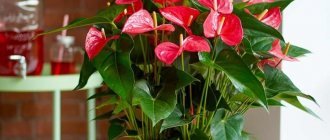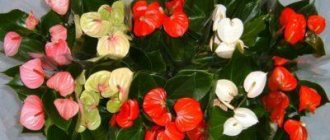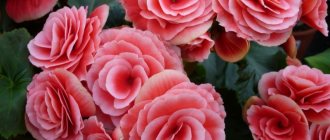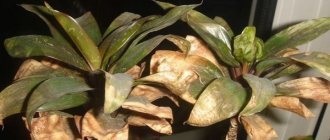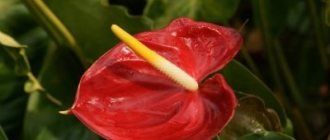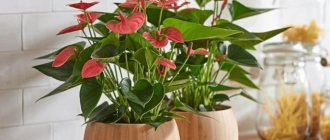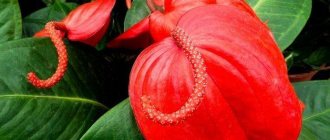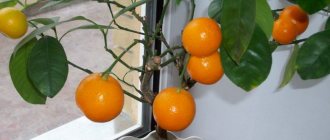Anthurium Scherzer description, photo
Scherzer's Anthurium (Anthurum scherzerianum) is an evergreen perennial that delights its owners with beautiful flowering. A representative of the Araceae family, the most numerous genus, uniting over 600 varietal species of evergreen liana-like and herbaceous crops. It is the Scherzer species that is most in demand among lovers of home crops. The name exotic comes from the Latin anthos - “flower” and oura - “tail”. The literal translation is “flower tail,” which fully corresponds to its appearance.
The culture comes from Central and South America. It has a short stem, rich green foliage on petioles 15-20 cm long. The foliage is collected in rosettes, and the curved inflorescence, similar to an orange cob, is wrapped in a heart-shaped red plate. At the end of flowering, round fruits of a fiery scarlet tone are formed. One representative can form up to eight flowers, delighting with their beauty for several months.
The culture has a popular name - “male happiness”. According to signs, this flower gives men health and longevity. The culture has several species and varietals, which also contain very miniature forms. Despite the fact that the culture positions itself as an undemanding house flower, it can hardly be called unpretentious. For the correct formation of all decorative features, the plant requires proper care and compliance with certain care requirements.
1.Seven secrets of success:
| 1. Growing temperature: summer - 20 - 25° C, winter - about 15° C. |
| 2. Lighting: in the morning and evening - direct rays of the sun, during the day - light shading. |
| 3. Watering and air humidity: a well-moistened substrate during the growing season, in winter in accordance with the air temperature in the room, air humidity is increased in spring and summer, taking care of its good movement. |
| 4. Pruning: Remove fading buds and old dying leaves. |
| 5. Soil: neutral or slightly alkaline porous soil. |
| 6. Feeding: during the entire growing season - 2 times a month. |
| 7. Reproduction: by seeds or by dividing large bushes when transplanting. |
Botanical name: Anthurium.
Anthurium domestica, flamingo flower or male happiness - family
Homeland of the plant. South America, the plants come from the South American rainforests, where the temperature ranges from 20 - 25 ° C and the air humidity is 80 - 100 percent. Anthurium in nature develops under the forest canopy and is not exposed to direct sunlight.
Popular varieties
Thanks to the work of breeders, today many miniature varieties of Anthurium with various shades of bracts have been developed. Among the most popular varieties presented in the windows of flower shops, these stand out.
Anthurium Scherzer
The most unpretentious variety among indoor varieties. The bush is rather low compared to its other brethren. The most popular Scherzer varieties are:
- “Lacetti” - this variety is grown not only as an indoor species, but also for cutting when decorating flower arrangements. It is distinguished by a peach-colored flower plate hugging a helical core-cob, fleshy foliage of a rich dark green tone with tapered ends.
- “Graffiti” - a distinctive feature of the variety is a wide white color plate with red specks and a fleshy structure.
- “Hawaii” - this exotic variety has gained popularity among soda growers due to the two- and three-color color of the flower plate.
- "Alexia Blue" - this species is distinguished by its flower cores of a soft blue tone, which makes it a favorite among gardeners.
- “Chocolate Love” - this variety has special decorative properties, which are manifested in the contrasting combination of dense shiny greenery with chocolate flower plates.
Indoor Anthurium Baker
Growing area: dense forests of Guatemala - Colombia. The foliage is dense and elongated. The inflorescence spadix is short, and the flower plate is creamy-green in color with a lilac border. At the end of the budding period, the plant produces rich scarlet fruits.
Anthurium Hooker
The exotic homeland is Trinidad, the Antilles, and monsoon forests. The foliage is large, peduncles reach a length of 80 cm. The flower ear is purple in color, the flower plate is soft green.
There are also these varieties: Anthurium Crystal and Clarinervium Clear-veined.
For your information! The most popular is Scherzer's anthurium mix, which consists of several varieties grown in one container.
We choose Scherzer for every taste
Thanks to its ease of care at home, various hybrids and varieties of Scherzer anthurium are increasingly found in stores. The difference between hybrids and varieties lies mainly in the color of the bract or the size of the plant itself. The most common of them is the Amaretti variety. It is easy to recognize by its white flower with red spots.
Based on the color of the Scherzer bracts, three groups of varieties can be distinguished:
- red anthurium – “Artus”, “Lybra”, “Rustica”, “Solara”, “Hanna”;
- green – “Arinos”, “Smaragd”, “Unica”;
- pink – “Lacetti”.
If you have limited space, but really want to have a Scherzer anthurium in your collection, we advise you to give preference to the dwarf variety. “Miniature Scherzer anthurium” during the flowering period has a height of about 7 cm. In any case, no matter what variety you choose, it will be an ideal interior element for both home and office.
Home care
Do not forget that the culture came to us from the tropical zone, therefore, home cultivation must fulfill all the requirements for the microclimate.
Location and lighting
In order to obtain the necessary lighting, the pots are placed on the window sills facing the northeast and northwest sides. The indoor flower prefers partial shade and diffused lighting. If there is insufficient light, it will be difficult to wait for the bush to bloom. And exposure to direct rays of the sun will cause the bush to dry out.
Air temperature and humidity
Temperature requirements vary depending on the season. During the spring and summer periods of active development, it is recommended to maintain the temperature within the range of 18-25. In the warm season, it will be quite common to feel exotic in an open area, but as far away from direct sunlight as possible. With the onset of cold autumn and throughout the winter, it is necessary to reduce the temperature to 15-17 degrees. By observing the temperature conditions, the plant will have the opportunity to properly lay flower stalks.
The flower has one feature - it requires a humidity level of 85-90%. This requirement can be met by placing the pot on a special stand with moistened expanded clay. Every day, the foliage must be wiped with a damp sponge or sprayed with a sprayer, without getting on the flower stalks. Moss or coconut fiber, which can be used to cover the surface of the soil in a container, will also help in the solution. In the future, when moistening the bush, it is necessary that the moisture-retaining material is also moistened.
Important! In winter, it is necessary to protect the plant from frosty drafts and sudden changes in temperature.
Watering and fertilizing
For watering, use soft filtered water. Before use, it is better to boil the water, let it cool and add a few drops of lemon juice. Watering is carried out regularly, but only if the substrate dries out approximately 5 cm deep. Excessive moisture or drying out of the soil has a detrimental effect on full growth and formation. High soil moisture will lead to rotting of the root system, and lack of moisture will lead to drying out.
Full care of anthurium involves the additional use of mineral and organic fertilizers. At the active growth stage, universal fertilizers are added to the soil at regular intervals of 10-14 days. It is important not to allow an excess of fertilizers. To do this, more experienced gardeners recommend making solutions of lower concentrations than the manufacturer indicates on the packaging. It is also necessary to ensure that the fertilizer does not contain lime. During the cold winter period, fertilization is not required.
Soil, pot, replanting
The crop can be grown in specialized soil, in treated pine bark, or using the hydroponics method. When using pine bark, an increase in the number of waterings and fertilizing will be required. The optimal substrate is considered to be a mixture of two parts of moss and peat, and one part of turf soil. You can add a little charcoal and ground bark. This mixture will provide the soil with good oxygen and moisture permeability.
Informative! The crop begins to bloom only after the entire volume of the pot is filled with roots. Therefore, it is not recommended to transplant into excessively large containers; each subsequent pot can be 1 cm larger than the previous one.
When it comes to soil, one very important rule must be observed - the substrate should not be compressed or compacted. The soil mixture should remain loose and fibrous and maintain excellent breathability. For the proper development of exotic plants, slightly acidic soil is preferred. Therefore, it is recommended to maintain the acidity level in the range of 5.0-6.0.
Young bushes are replanted every year. But replanting bushes older than 5 years is performed as needed, as a rule, no more than once every 3-4 years. The root system of the exotic plant is fragile and brittle; as a result, extreme care should be taken when moving the bush. For further development of the root system and the formation of new shoots during the transfer process, the plant goes slightly deeper into the new substrate.
Common mistakes when caring for Anthurium
Describing the indoor anthurium flower and how to care for it, one cannot help but list the common mistakes that inexperienced gardeners make. Since the plant grows in the tropics, some housewives provide it with excess light, from which “male happiness” simply dies.
In cold winter, some flower owners forget to provide enough heat, because of this the leaves become stained, the bush weakens and withers.
It is important to ensure that the temperature in the room is around 18 degrees and in no case drops below 15°C
Sometimes inexperienced gardeners provide abundant watering to the plant, causing its roots to rot. To prevent this from happening, after watering, drain the remaining water from the pan, and also observe the soil moisture regime in accordance with the season.
A beautiful tropical plant - Anthurium is easy to grow at home
It is important to follow simple rules to maintain active flowering and visual attractiveness of the bush.
Reproduction methods
The culture can reproduce in several ways:
- seed;
- dividing the bush;
- cuttings;
- lateral processes.
The seed propagation method in this case is a very difficult and unproductive process. As a rule, it is used by breeders to obtain new species. And a flower grown from seeds will bloom no earlier than 3-4 years later.
The most effective method of growing anthurium is dividing the bush. This method is performed by dividing the mother flower into cuttings. The most suitable time for cuttings is considered to be spring. The plant is removed from the container and young shoots along with the root system are carefully separated from the general bush. The separation area is treated with crushed coal. The resulting seedlings are transferred to separate containers filled with nutrient soil.
Most species are able to reproduce by cuttings. A part of the shoot with aerial roots is selected and cut off at an angle. The cut site is dipped in a means for rapid root growth. The selected shoot is planted in moistened vermiculite, buried 3-5 cm into the soil.
Cover the top with a jar or bottle to create a greenhouse effect. For good rooting, high air humidity, a temperature of 23-25 degrees Celsius, and long daylight hours with diffused lighting are required. When the cutting has formed roots about 5 cm long, it can be transplanted into a container with a nutrient mixture.
Reproduction by lateral shoots is also often called reproduction by “babies”. During the process of transplanting the main bush, the side shoots are separated with a sterile scalpel and transferred to a moistened mixture of sand and peat to form the root system. Once the seedlings have formed a root ball, they can be transferred to containers for continued growth.
Know! You can replace vermiculite with soft water. In it, shoots can grow roots with the same ease.
Anthurium mix
Mix is a compact variety among its brothers. A distinctive feature is its miniature size. The height of the mix does not exceed 20cm. This hybrid is created from a couple of the most popular varieties. This variety was bred by breeders and is well adapted to indoor breeding conditions. And the variety of colors can decorate any room.
Mixes do not require special care. Often, mixes are mini-plants, which allows you to grow several specimens on the windowsill at once. The juxtaposition of several mixes with different colors is especially fascinating, because there is quite a large selection of them - from milky white to a bright scarlet flower. From all the variety, you just need to choose a copy to your liking.
Anthurium Andre mix is an evergreen representative of the exotic. The leaves are large, juicy, fleshy, dense green in color. The bract has a heart shape and can be snow-white, orange, scarlet, green, or pink in color. If you follow the rules of care and maintenance, flowering continues throughout the year. flowering continues throughout the year. The maximum height of the stems can reach 75-80 cm.
Anthurium Scherzer mix - has a fairly small size. The foliage is slightly elongated and shaped like a heart. The bract plate is generally slightly elongated oval in shape. The most common are pink, fiery yellow and scarlet-orange shades. The inflorescence of the hybrid has been preserved in its original form - a spiral shape. This hybrid has not gained much popularity, but caring for it is very simple and does not take much time.
Anthurium mix by Andre and Scherzer - bred using the most popular species, the names of which are displayed in the title. The color of the flower bedspread can vary from soft white to deep scarlet tone. It all depends on the varietal variety. Green, pink and orange tones may also be found. It can reach 80 cm in height, but often grows 50-60 cm in height. Breeders worked to ensure that the hybrid became as unpretentious as possible and adapted to home cultivation. Flower growers love this cut flower.
Description of the plant
The most compact of all indoor anthuriums, scherzerianum is considered a model of elegance and restraint. Dark large leaves and bright covers around the inflorescences contrast effectively and harmonize in size.
Anthurium Scherzer is an evergreen herbaceous perennial that pleasantly stands out among other representatives of anthuriums with its compactness. Bushes are limited to a height of 30-35 cm. Scherzer's anthurium has thin but powerful roots and a shortened, almost invisible, often underground stem. These anthuriums are elegant due to their beautifully curved leaves and graceful petioles. Cylindrical, up to 3 mm in diameter, they are slightly shorter than the leaves and several shades brighter in color.
The leaves of Scherzer's anthurium are large but neat, from 5 to 25 cm in length, leathery, pointed-oval, semi-matte on the top and always matte on the bottom. They stand out pleasantly from their counterparts with less noticeable veining and richness of dark tones. The greenery seems simpler, but the bushes are also neater.
Like all anthuriums, Scherzer is characterized by a typical structure of inflorescences - ears up to 8 cm long are surrounded by a bright spathe up to 12 cm long. Peduncles are straight, longer than the leaves. It is quite easy to recognize this particular species thanks to the large, bright spathes and the special curved or spiral shape with a narrowed tip at the cobs. They resemble, depending on the variety, a corkscrew, a mouse or pig tail, or the neck of a flamingo.
Spreads with bright, warm red-orange tones are typical of Scherzer anthurium, but there are more and more varieties with pink and “powdery” colors. Wide, large, rounded-heart-shaped, asymmetrical, arching, with pronounced veins that give them relief, the bedspreads seem waxy and very dense.
Scherzer anthuriums can bloom for longer than four months; the timing largely depends on the variety and maintenance conditions, especially lighting in winter. Traditionally, flowering occurs in the warm season, spring and summer, but flowering anthuriums can be found on sale and with additional lighting in winter.
This is not the most diverse, but reliable plant from the Anthurium genus can offer about 40 decorative forms and varieties. It is better to choose Scherzer anthurium according to your taste and the color of the inflorescences.
Anthurium scherzerianum. © latiendadeinverflor
Anthurium Scherzer mix home care
In order for an exotic flower to delight with its unsurpassed beauty of flowering, it is extremely important to choose the right place for growth. This should be the western or eastern side. It is also necessary to control the level of humidity and air temperature, because this exotic beauty is accustomed to the warm climate of the tropics. But at the same time, water stagnation in the soil should not be allowed, because then the risk of rotting of the root system increases. Exposure to drafts on crops is strictly prohibited.
Remember! The root system of anthurium develops very well, regardless of the age of the plant. Therefore, the culture must be periodically transplanted into a container of larger diameter.
Superstitions associated with the Anthurium flower
Some flower growers believe that the plant not only decorates the room, but also protects the occupants of the room, gives good luck and helps in difficult life situations. Another name for the flower, “male happiness,” was not invented by chance. It is believed that the bush protects the families of newlyweds and gives them good luck, which is why anthurium is often presented as a wedding gift.
In order for love and mutual understanding to reign in the house, this flower is often bred together with spathiphyllum, which is also called “women’s happiness.” The two plants, even externally, are a little similar and look harmonious on the same windowsill.
Diseases, pests and control methods
All crop diseases are associated with specific growing conditions. It can be affected by all kinds of rot caused by excessive soil and air moisture. The disease can only be defeated at an early stage of its manifestation. To do this you need:
- remove affected areas of roots or shoots;
- transplant the bush into a new container with fresh substrate and treat with fungicides.
Anthracnose is a particularly dangerous disease. It can be transmitted from an affected bush to a healthy one, or settle on a plant after watering. Signs of this disease are drying of the leaves along the contour and their further death.
An exotic guest can be attacked by such harmful insects as spider mites, aphids, mealyworms, thrips, scale insects, and whiteflies. The presence of parasites is accompanied by certain symptoms. Most often, bushes are affected by spider mites. The consequences of the attack of the parasite are yellowing of the leaves and the appearance of specks on their surface. Initially the specks are yellow in color, but over time they turn black.
When aphids multiply, the greenery on the bushes wrinkles and becomes covered with yellow spots. Mealyworm leaves behind chewed holes in the foliage.
Scale insects are the most common and dangerous enemy. It can take months to fight this pest. It will take a lot of effort and patience to rid the flower of the persistent parasite. The scale insect and its larvae leave a yellow sticky coating on the surface. The insect draws all the vital juices from the bush. As a result of such proximity, the plant loses its vitality, the foliage turns yellow and becomes deformed, and the growth and development of the bush stops.
Any pest is eliminated by spraying the bush with insecticidal preparations prepared in strict compliance with the manufacturer’s instructions. It is also necessary to remove all visible individuals and their larvae from the surface of the bush. Cut off injured shoots, peduncles and leaves.
Remember! If the affected plant is not treated, it will die. In addition, infection of neighboring crops is possible.
Pleasant to the eye and beneficial
Anthurium Scherzer is a symbol of elegance; it can be given in a pot, made into various bouquets, and also used in phytodesign to complement any interior. The uniqueness of anthurium lies not only in its widespread use in floristry and phytodesign, but also in its beneficial properties. It can lift your spirits, relieve fatigue and help restore strength.
According to Colombian superstition, this flower brings happiness and prosperity to the house. Anthurium is especially popular among newlyweds, who decorate their homes with various bouquets of this beautiful plant. Whether you are superstitious or not, in any case, the Scherzer anthurium will always delight you with its beauty if you follow the basic rules of care.
Possible growing problems
In fact, the flower is very unpretentious and if you take care of the plant, there will be no problems in growing it. However, novice flower growers, trying to fulfill all the requirements as much as possible, make many mistakes, which later lead to the development of diseases. But if the cause of the disease is detected in a timely manner and eliminated, the plant will quickly come to life.
If the maintenance conditions are violated and the flower is kept at low temperatures or in bright light, the foliage may turn yellow. A little later, dead areas form on the surface of the leaves. If the bushes are grown in heavy soil, or the drainage in the container is incorrect, the root system may rot. Such a plant must be transplanted immediately. Despite the fact that the crop is moisture-loving, excessive watering can also cause root rot.
In some cases, bushes do not produce buds for a long time. This problem can arise when there is insufficient lighting, too large a growing container, non-compliance with temperature conditions, or a lack of nutritional components in the soil. If all possible causes are eliminated, the flower will quickly delight you with a new peduncle.
Using hard and cool water causes the leaves to turn black. It is extremely important that the water for irrigation is filtered and at room temperature. Insufficient humidity in the room leads to blackening of the edges of the foliage.
Anthurium Scherzer and Andre differences
At first glance, these two species are very similar to each other. However, Scherzer's foliage is more elongated, the color plate is more oval, less glossy and sometimes slightly inverted. Scherzer, unlike Andre, is small in size. It reaches a height of 30 cm, which makes it more attractive for home gardeners. Another important difference is that in the Scherzer variety the inflorescence is twisted into a spiral, while in Andre it is straight. Andre's hybrid varieties are able to maintain flowering throughout the year, which cannot be said about its twin.
